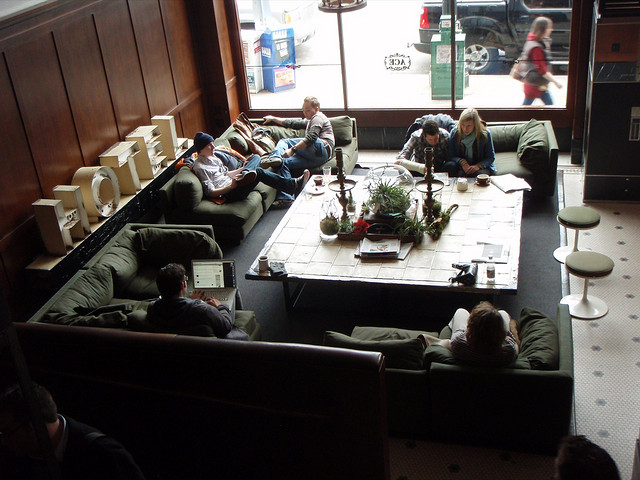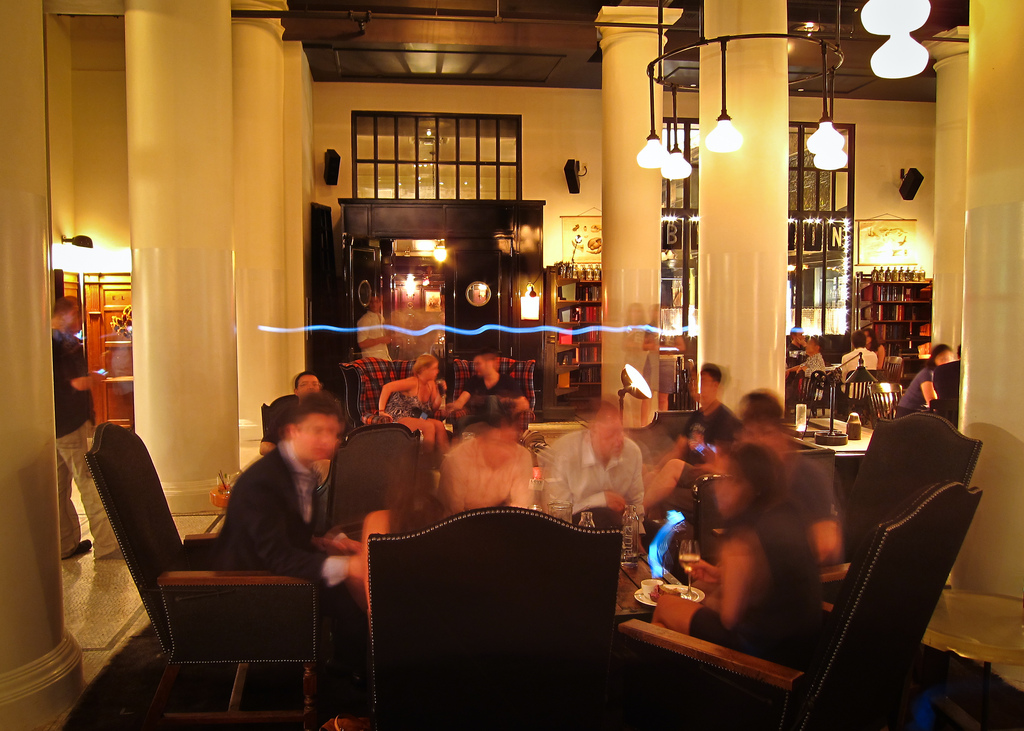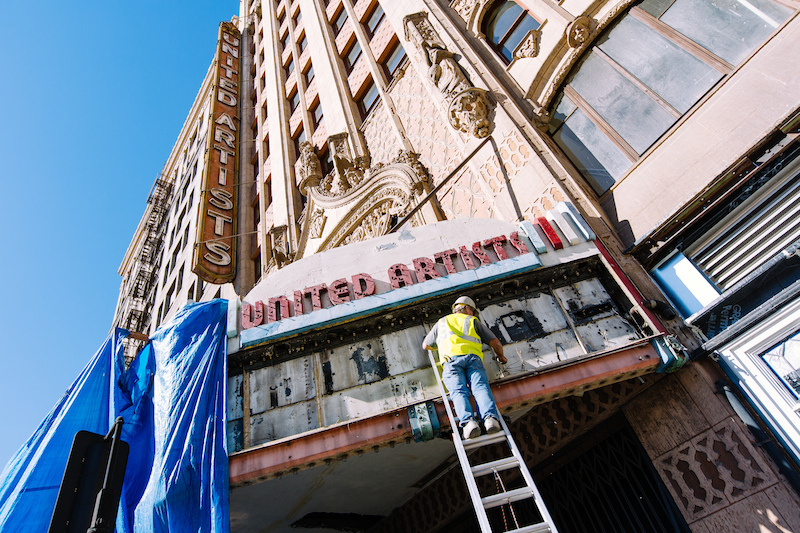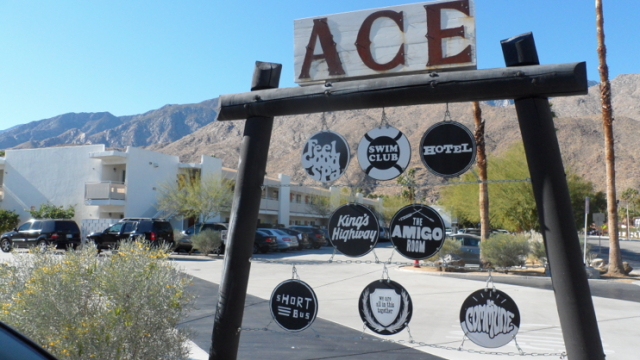Last Friday, Ace Hotel founder Alex Calderwood was found dead in London, where the chain had just opened its fifth location. He’s being remembered today as a design visionary, the leader of a cultural phenomenon. But his role was also that of a city-builder, reaching far outside hotel walls to build community and instil a sense of place in each neighbourhood he touched.
Calderwood began his career in the early 1990s reinventing one of the cornerstones of the urban neighbourhood: the barber shop. His version, called Rudy’s, offered “cheap, chic” cuts in storefronts that borrowed traditional elements like chrome chairs and straight razors from your grandfather’s era, but he updated the vibe with street art shows and an indie rock playlist. Timed perfectly with the emergence of the DIY movement, Rudy’s was a runaway sensation that inspired hundreds of copycat businesses across the country.

The first Ace Hotel opened in Seattle’s Belltown neighbourhood in 1999, photo by Jason Brown
It has not been as easy to copy the Ace, with its unique “high-low” business proposition offering cushy, turntable-equipped suites alongside bunkbeds and shared bathrooms. Clever design played a huge role here, as Calderwood tapped firms like Commune and Roman and Williams who had a gift for blending flea market finds with their own custom furniture creations.
But it was also about the entire streel-level package that the Ace brought to any city. A development would bring not just a walled-off hotel but an immersive cultural experience: a ground-floor restaurant, a Stumptown Coffee, sometimes a branch of Rudy’s, a boutique, a gallery or a performance venue — each carefully branded and curated by Calderwood’s creative team, Atelier Ace.
When the first Ace opened in a former flophouse in Seattle in 1999, Calderwood set a precedent that would come to define what made the Ace such a valuable proposition for the cities it came to inhabit. Ace Hotels would situate themselves right at the bleeding edge of the next great neighbourhood — some guests who have had to dodge drug dealers and prostitutes on the way back to their rooms might say a little too close to that edge. But the transformation would come soon enough as the Ace attracted like-minded businesses and residents.

The Ace Hotel lobby in Portland, Oregon is part of a large cultural complex, photo by eldan
You can see this for yourself when you walk the blocks around any Ace. In New York, the Ace has proudly asserted itself as the centre of a thriving new, branded neighbourhood called NoMad (North Madison). In Portland, the Ace is the anchor for a new cultural corridor named Union Way, where several ballrooms and nightclubs have been converted into a series of boutiques and restaurants — each of them seeming to nod in some way to the Ace’s honed aesthetic.
I’d also argue that Calderwood changed the way we thought of the hotel as a public space itself. You’ve read the stories about the Ace’s New York lobby, which have described it as a cool-kids Starbucks where scenesters aren’t ashamed to be seen hunched over a laptop. Before the Ace, hotel lobbies were stuffy or sterile spaces designed for guests and guests only. But the archetypal Ace lobby is a true living room, with overstuffed couches, long slate-topped tables salvaged from libraries, free wifi, good cocktails, and a policy that says anyone is welcome.

Laptops and phones aglow at the Ace Hotel’s New York lobby, photo by Nan Palmero
I saw Calderwood’s community focus illustrated to great effect when I first visited the Ace Hotel in Palm Springs, the first Ace location with a pool. Here, true to form, the Ace had somehow made a Howard Johnson’s motel into an authentic bohemian oasis, in a city that we’ll say is not known for its youthful vibe. But on the 115-degree weekend we were there, I was surprised to see plenty of people who didn’t fit the typical Ace customer lounging poolside. Later, when I wrote a story about the property, I was surprised to learn of one of the Ace’s most progressive policies: Anyone who lived nearby could use the pool for a small fee. I thought back to the local residents I’d seen, ecstatically taking a dip on that sweltering Saturday. It was a truly a neighbourhood pool.
A few weeks ago I was lucky enough to tour the next location of the Ace to open, just on the border of a revitalised Broadway, in downtown Los Angeles. It’s perhaps the most ambitious Ace yet: converting hundreds of ancient offices in the United Artists Building into contemporary hotel rooms. Built in 1927 to house the production company owned by Charlie Chaplin, Douglas Fairbanks and Mary Pickford, the building is an architectural treasure but for the past several decades it had been occupied by a well-meaning but not preservation-minded church, as evidenced by the neon sign on the roof proclaiming “Jesus Saves.” (The sign is, of course, staying.)

Renovations at the Los Angeles Ace, scheduled to open in 2014, photo by Hunter DTLA
The most monumental accomplishment for this Ace Hotel is the renovation of the United Artist Theatre, a 1000-seat movie palace on the building’s ground floor. Walking into the vast space stripped of its seats (which were off-site at the moment, being reupholstered), I felt like I was stepping into a cavern that’d been sealed off to civilisation for centuries, its Spanish Gothic ceiling dripping with carved wood stalactites. Who would have ever come along to save this place, I wondered, if it wasn’t for the Ace?
Up and down Broadway you can see the largest concentration of century-old movie theatres in the country, many of them a mess of broken neon tubes and crumbling terrazzo. But I got the sense that as soon as the Ace moves in, those marquees would start to light up one by one.
Top image: The Ace Hotel in Palm Springs, via More Than Mary
